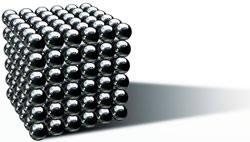Should this toy be saved?

Illustration by Bob Schuchman
After a 6-year-old Canadian girl swallowed 19 superstrong, pea-size magnets in March, she told her mother she thought they were candy. The magnets failed to pass through naturally, and a surgeon removed them three days later, finding a perforated small intestine, ulcerations in the stomach and two small holes in the bowel.
The rare-earth magnets with the brand name Buckyballs had been a gift for the woman’s two children, the other a 2-year-old. “I thought nothing of it,” she told a reporter.
The girl’s mother likely had no way of knowing of the problems rare-earth magnets can create, unless she happened upon news accounts of similar incidents or the magnets came packaged with a warning label that she actually read. Or perhaps she just wasn’t careful enough with her children handling small objects.
The latter view tends to dominate in comment sections in blogs about Buckyballs. Their misuse attracts zingers aimed at the parents by invoking, among other things, Darwinism and questionable fitness for raising kids. But the issues for product safety are more subtle and complex.
Last July, the Consumer Product Safety Commission filed an administrative complaint seeking to ban the sale of Buckyballs, which were marketed as adult novelties—a sort of work-desk alternative to doodling. They can be stacked, aligned and extended to build forms and shapes that seem to defy gravity. But they sometimes find their way down the gullets of children and then, with strength exponentially greater than typical magnets, they try to join each other.
The company folded several months later, giving up its catchy PR effort (“Save Our Balls” got a lot of sympathetic news coverage) and walking away from an expensive court battle against the agency. The CPSC later sued two more companies, Zen Magnets and Star Networks, which have continued selling the strong-magnet balls. The three cases might be combined.
The products are still being marketed, and tens of millions of Buckyballs remain in consumers’ hands, as well as loose on floors under furniture. The issue brings bright light and sharp focus on an agency that until just a few years ago had receded into the fuzzy, forgotten margins of the federal bureaucracy.
Click here to read the rest of “Should this toy be saved?” from the May issue of the ABA Journal.



